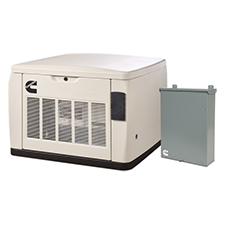
How Electricians Can Help Homeowners Navigate Backup Generator Options
It’s not a secret that severe weather events are increasing in the United States. Warmer ocean temperatures are driving more intense – and wetter – coastal storms and hurricanes. And Western U.S. residents are seeing both torrential rain and snowstorms and drought conditions that pose high fire risks, depending on the region. And the states in between are seeing a mix of all-of-the-above. It often only takes one or two weather-related electrical outages for consumers to consider installing a backup generator, but they can feel overwhelmed by their options and related costs. Electrical contractors have the opportunity to become a trusted advisor by walking these prospective customers through important decisions on sizing and control systems.
Initially, a homeowner might just be looking for an automatic transfer switch (ATS) to be installed, so they can wheel out a portable generator, when needed, to keep the furnace and refrigerator running when the utility grid is down. It might not take long, though, for that inconvenience, along with low power output and the need to protect the generator from inclement weather, to lead a consumer to a permanently installed standby unit. If you’re the contractor who installed the ATS, you’ll likely be first on that buyer’s call list.
The big budget issue, of course, will be sizing the generator to adequately meet the homeowner’s needs. In the past, this might have meant deciding in advance which circuits to power in a utility outage and which to let remain off. Essential circuits would then be wired to the unit’s ATS, ready to be supported during the next outage. Doing this calculation could lead to the need to move to a larger and more expensive generator.
Now, though, more advanced ATS devices feature added intelligence to let consumers prioritize loads in a way that could allow a smaller generator to support more circuits than was previously possible. Smart load-management capabilities allow these switches to selectively shed loads as needed when higher-priority demands kick in. So, for example, instead of having to upsize to accommodate both an electric water heater and an air conditioning (AC) system, the load manager could simply disconnect the AC condenser when the water heater kicks in to support a bathroom shower.
Understanding – and being able to communicate – workarounds like these can help electricians and electrical contractors develop lasting customer relationships. It might make for a less-profitable project, upfront, but it also could make you the preferred provider for any number of jobs, going forward.
Initially, a homeowner might just be looking for an automatic transfer switch (ATS) to be installed, so they can wheel out a portable generator, when needed, to keep the furnace and refrigerator running when the utility grid is down. It might not take long, though, for that inconvenience, along with low power output and the need to protect the generator from inclement weather, to lead a consumer to a permanently installed standby unit. If you’re the contractor who installed the ATS, you’ll likely be first on that buyer’s call list.
The big budget issue, of course, will be sizing the generator to adequately meet the homeowner’s needs. In the past, this might have meant deciding in advance which circuits to power in a utility outage and which to let remain off. Essential circuits would then be wired to the unit’s ATS, ready to be supported during the next outage. Doing this calculation could lead to the need to move to a larger and more expensive generator.
Now, though, more advanced ATS devices feature added intelligence to let consumers prioritize loads in a way that could allow a smaller generator to support more circuits than was previously possible. Smart load-management capabilities allow these switches to selectively shed loads as needed when higher-priority demands kick in. So, for example, instead of having to upsize to accommodate both an electric water heater and an air conditioning (AC) system, the load manager could simply disconnect the AC condenser when the water heater kicks in to support a bathroom shower.
Understanding – and being able to communicate – workarounds like these can help electricians and electrical contractors develop lasting customer relationships. It might make for a less-profitable project, upfront, but it also could make you the preferred provider for any number of jobs, going forward.
Photo courtesy of Cummins



